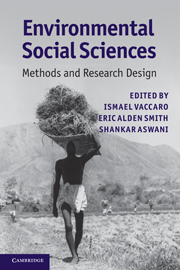Book contents
- Frontmatter
- Contents
- Contributors
- Foreword
- Preface
- 1 Introduction
- 2 People, numbers, and natural resources: demography in environmental research
- 3 Production decisions and time allocation: a guide to data collection
- 4 Analyzing the politics of natural resources: from theories of property rights to institutional analysis and beyond
- 5 Extreme events, tipping points, and vulnerability: methods in the political economy of environment
- 6 Local communities and natural resources: ethnobiology in practice
- 7 Mapping histories: cultural landscapes and walkabout methods
- 8 Metaphors and myths in news reports of an Amazonian “Lost Tribe”: society, environment and literary analysis
- 9 Water decision-makers in a desert city: text analysis and environmental social science
- 10 Linking human and natural systems: social networks, environment, and ecology
- 11 Khat commodity chains in Madagascar: multi-sited ethnography at multiple scales
- 12 Spatiotemporal methodologies in environmental anthropology: geographic information systems, remote sensing, landscape changes, and local knowledge
- 13 Deep time, diachronic change, and the integration of multi-scalar data: archaeological methods for exploring human–environment dynamics
- 14 Comparing trajectories of climate, class, and production: an historical ecology of American yeomen
- 15 Socioecological methods for designing marine conservation programs: a Solomon Islands example
- Index
- References
11 - Khat commodity chains in Madagascar: multi-sited ethnography at multiple scales
Published online by Cambridge University Press: 05 June 2012
- Frontmatter
- Contents
- Contributors
- Foreword
- Preface
- 1 Introduction
- 2 People, numbers, and natural resources: demography in environmental research
- 3 Production decisions and time allocation: a guide to data collection
- 4 Analyzing the politics of natural resources: from theories of property rights to institutional analysis and beyond
- 5 Extreme events, tipping points, and vulnerability: methods in the political economy of environment
- 6 Local communities and natural resources: ethnobiology in practice
- 7 Mapping histories: cultural landscapes and walkabout methods
- 8 Metaphors and myths in news reports of an Amazonian “Lost Tribe”: society, environment and literary analysis
- 9 Water decision-makers in a desert city: text analysis and environmental social science
- 10 Linking human and natural systems: social networks, environment, and ecology
- 11 Khat commodity chains in Madagascar: multi-sited ethnography at multiple scales
- 12 Spatiotemporal methodologies in environmental anthropology: geographic information systems, remote sensing, landscape changes, and local knowledge
- 13 Deep time, diachronic change, and the integration of multi-scalar data: archaeological methods for exploring human–environment dynamics
- 14 Comparing trajectories of climate, class, and production: an historical ecology of American yeomen
- 15 Socioecological methods for designing marine conservation programs: a Solomon Islands example
- Index
- References
Summary
Introduction
This chapter addresses theoretical and methodological concerns of multi-sited research with reference to a study of khat in Madagascar. The bushy khat plant, whose leaves are chewed fresh for a mild amphetamine effect, grows well in the cool temperatures of the Mt. d’Ambre region in northern Madagascar. Khat first arrived in Madagascar with Yemeni dock workers, hired under a French colonial regime, in the early to mid twentieth century. Its growing local popularity has meant a significant increase in revenues for farmers over the last 10–15 years. Today khat is primarily chewed in Yemen, in parts of the Horn of Africa, Somalia, Kenya, Ethiopia, and in immigrant communities from those regions abroad (Carrier and Gezon 2009).
By localizing Malagasy khat production within a broader context, this chapter investigates links between the economic processes of production, distribution, and consumption – often referred to as a commodity chain. These interconnected dynamics occur in multiple geographically dispersed locations, involving many different actors. Understanding the effects of khat requires research in multiple locations to determine how geographically dispersed variables affect each other. The draw toward a multi-sited approach emerged from a general interest in explaining forest degradation, with the question: What are the major pressures on the Mt. d’Ambre forests? Upon learning that khat production had increased tremendously on the north and east sides of the Mt. d’Ambre, a more focused question emerged: What is the relationship between the expansion of khat production and deforestation? We hypothesized that people are cutting down forests in order to grow khat. A multi-sited approach, focusing on the commodity chain, made sense for understanding how demand outside of the immediate region of production influenced local decision-making and land use patterns.
- Type
- Chapter
- Information
- Environmental Social SciencesMethods and Research Design, pp. 238 - 265Publisher: Cambridge University PressPrint publication year: 2010
References
- 7
- Cited by



